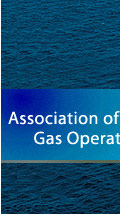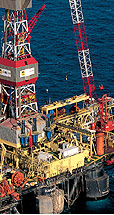AOGO - WorkingPaper on OALP
This paper is being developed under the following chapters.
BACKGROUND
Introduction of OALP was first suggested in 2004, during First Wednesday Club meeting organized by CII and attended by then Minister of Petroleum and Natural Gas. The then Joint Secretary Exploration was asked to prepare a concept paper.
Both the original paper and DGH suggestions were discussed at subsequent meetings of Wednesday Club. It was felt that the data available was inadequate and National Repository Organization was too far off to launch OALP along with NELP V as originally wished.
DGH has been working on the data procurement from existing NELP, Pre NELP and Nomination blocks. During a special session of AOGO in August 2007, DGH announced its intentions to proceed with OALP during 2008.
AOGO formed a small group of representatives from ENI ONGC and Premier to consider various issues involved, and the enclosed represents their views.
This draft position paper is now presented to the General Body for their comments and review.
EXECUTIVE SUMMARY
AOGO should encourage introduction of OALP, both in areas of adequate and inadequate data
There shall be two types of bids
For reconnaissance
For Exploration
Exploration bids should follow a common criterion of BEC etc. as NELP. In this case the difference between NELP & OALP shall be that
Blocks are not predefined. These are user defined by the first party envisaging interest in the area.
any explorer can bid for any unallocated area at any time
If an explorer believes that data is not adequate by his reckoning, he can bid even this area for reconnaissance. Such bids shall be accepted if there is no exploration bid for this area.
- Inadequate data blocks shall be bid for Reconnaissance. This shall be a short period phase. Subsequent to this phase the block, shall be put up for rebid. Rebid can be for reconnaissance or exploration.
- An exploration bid wins over a reconnaissance bid every time.****
- In case the Reconnaissance Company wishes to continue but loses the subsequent bid, it shall have some options to participate/recover loss, as a prior right.
**** There is also a view that in a developing area (defined later) if the first expression of interest is reconnaissance, it should lock the block for reconnaissance.
ISSUES ON DATA
3a. OALP offers flexibility to the companies to focus on the areas of their choice and develop niche expertise, which could be a win-win position for both industry and Government. It also offers opportunity to new players to enter the play whenever their resources so permit, and by offering multiple opportunities and staggered times take away the pressures which have resulted in many overaggressive bids in NELP. Exploration companies welcome the changeover to OALP.
3b. over the years the companies have often complained of inadequacy and poor quality of data, even in cases where Government has called for bids and assured of data. It is therefore likely that the even with the creation of data repository the data issues are going to be there for quite some time.
3c. Companies are supposed to provide data to DGH, both for NELP, Pre NELP and nomination eras. While this requirement has been expressed in many forums, there is a belief that the implementation of this is far from satisfactory. Not only are there still issues to be resolved in terms of types of data and age of data, but also there are problems with nomination era data, analog era data, and not traceable data. Once again the time frame for getting repository going is an open question.
3d. it is the exploration companies who put down money and take the gamble on finding hydrocarbons. It is the owner ( Govt.) who wants speedy and total exploration at the earliest. The history suggests that the data provider and data user are not always on the same page. A healthy solution must provide for a way to positively resolve this issue and move forward.
3e. In view of a perceived position where data acquisition to adequate quantity and quality takes some time, NELP and OALP co-exist for some time, a certain pressure remains for some blocks to be released for NELP every year, it is felt that the OALP should provide companies to bid for both the blocks where adequate data exists as well as blocks where data is inadequate or poor quality or nonexistent. As the amount of work and risks are very different, the system should provide for both entry and exit at different points. At the same time it should provide for the Governments interests should be protected to get bids with competitive work programs and return to Government.
OALP CHARACTERISTICS
Characteristics which distinguish OALP from NELP are
The bids can be made at any time.
The number of blocks bid at any time is variable starting with at-least one.
Within certain constraints the size/ shape of the block is dependent on the bidder
PROPOSED SYSTEM
1. Initially NELP & OALP to co-exist
2. OALP to consist of two parts
a. Reconnaissance phase to bring data position at par with NELP blocks/ develop information on the blocks till they are evaluated to be attractive for exploration
b. Exploration phase which parallels NELP as modified from time to time
3. There shall be a provision to exit after reconnaissance phase without any penalty or reward, as long as work program is completed. The other options shall be to continue reconnaissance phase (say for R&D blocks) or enter exploration.
4. Subsequent program at the end of reconnaissance phase (Further survey or exploration) shall require a separate bid. To encourage proper bids, it shall be possible for a new party to emerge winner and acquire and operate block.
5. First reconnaissance bidder who does not wish to exit but looses bid and consequently right to continue (further survey or explore), he shall have a prior right to participate in further program. This is his upside. In this case he does not get any other reimbursement.
6. If the reconnaissance bidder wishes to continue (further survey or explore) but looses the bid, he shall also have the alternate option to partially recover the cost of data from the winner. This shall be on a predetermined formula. This amount shall be permitted to be cost recoverable for the new winner.
7. Penalties for non completion of work program shall be similar to the prevalent NELP regime.
8. Force Majeure conditions need to be revised, as the current terms are seen to be too heavily weighed in favor of Government.
SCHEMATIC FOR OALP
| Exploration Co. “A” Develops interest in an area “X” |
Time Line |
|
|
|
| “A” approaches DGH with written expression of interest |
During Q(-1) |
|
|
|
| At the end of the quarter ,DGH advertises for all areas which have suitors |
End Q(-1) |
|
|
|
DGH receives “n” bids
Including from “A” |
|
|
|
|
At the end of the following quarter DGH selects the best bid as per “Reconnaissance Bid Criterion”
Let us say Winner is “R” |
End Q(0) |
Best Bid wins.
No prior rights for “A” whether it wins or loses |
|
Exploration Bids have a priority over Reconnaissance Bids every time |
| Reconnaissance Begins |
Q1 |
|
|
|
| |
Q2 |
|
|
|
| |
Q3 |
|
|
|
| |
Q4 |
|
|
|
| |
Q5 |
|
|
|
| |
Q6 |
|
|
|
| |
Q7 |
|
|
|
| “R” submits data to DGH |
During Q8 |
|
|
|
| DGH advertises the Block is available for rebid |
End Q8 |
|
|
|
| Bids Received |
During Q9 |
|
|
|
Winner for further work selected.
Let us say Winner is “E” |
End Q9 |
|
|
|
| |
|
If “E” is same as “R” |
If “E” is different than “R” |
|
| |
|
No Prior Rights |
“R” gets 1 week to exercise “prior rights” for participation or reimbursement |
|
For Exploration NELP regime begins
For Reconnaissance another round of OALP regime continues. |
|
|
|
|
| Start of Phase I ……………… |
|
|
|
|
DEFINITIONS OF TERMS USED
Area Classification
All areas are classified into three groups
a. Deepwater
b. Developing Areas
c. Developed Areas
is classification should be done by a joint group of DGH and technical experts from industry.
Developed areas are areas in prospective basins, or areas where in the view of DGH adequate reconnaissance has been done/ adequate good quality data exists. Definition of “Developed Area” shall be as in Annexure – II
Deepwater are areas with more than 400/800/1000m water depth.
Rest of areas is defined as developing areas. Definition of Developing Area shall be as in Annexure – II
The joint group shall produce a map on which different areas shall be clearly marked along with Lat-Long information.
Area Bid
The bid shall be for contiguous area only, and shall be built up on multiples of grid specified by DGH.
Recommended grid size is 2’x2’ (2 minx2 min)
A single bid can be for the following areas
| Area Classification |
Minimum Area – Sq Km |
Maximum Area – Sq. km |
| Deepwater |
1 sq.grid |
10 000 |
| Developing Area |
1 sq.grid |
2 500 |
| Developed area |
1 sq.grid |
1 500 |
Bid Evaluation Criterion for Reconnaissance
Reconnaissance work program includes all activities except drilling of wells.
DGH shall prepare a “standard table” which converts each activity into a “Standard Rupee Value” e.g.
| Work |
Standard Rate |
Per |
| Review existing data- preparation of geological maps, Landsat, topography, aerial photo interpretation, lineament analysis etc. etc. |
|
|
| |
|
|
| Geological mapping including biostratiigraphic, reservoir characterisation, source rock geochemical studies |
|
|
| |
|
|
| Surface geochemical survey |
|
|
| |
|
|
| Aero magnetic Survey Air/Land |
|
Sq km |
| |
|
|
| Other survey types( EM etc) |
|
|
| |
|
|
| 2 D reconnaissance seismic ( diff. grid size) |
|
Line Km |
| 2 D prospect seismic (diff. grid size) |
|
Sq Km |
| |
|
|
| 3D seismic |
|
|
| |
|
|
| Stratiagraphic drilling |
|
|
Bid shall have a single item of “standard value of Work Program”
Max value wins.
Submission of Data
At least 4 weeks before the end of contract period, the operator shall submit to DGH the data as listed in Annexure I on the formats standardized and listed therein.
Extensions
Incase of a Force Majeure’ condition an extension may be permitted by DGH.
Incomplete Work
In case the Reconnaissance winner “R” is not able to complete his bid work program, his completed work shall be worked out as a % of work bid.
Penalties shall be as worked out as per the prevalent NELP regime.
Bid Evaluation Criterion for Exploration Bids
'
This shall be same as for NELP
Prior Rights
If the Reconnaissance Company “R” looses the Exploration bid, it has the option of exercising either of following options as a prior right
1. Reimbursement of Standard Cost of Work bid and done. The new winner “E” shall have the right to cost recover it
2. Participate in the block as a non-operator to the extent of “P” % say 25%
Vicinity Areas Rights-I
In case of a discovery and technical basis of “Suspicion of Extension” of reservoir in the adjoining unallocated areas, the discoverer shall have the following Prior rights on claiming extension of his area
a. 3 D seismic
b. Drilling of appraisal wells
This exclusive right shall be available for a period not exceeding two years. Claim on any Hydrocarbons discovered is exercisable only on provable extension of the reservoir already established in parent block. In case an exercisable claim is accepted, the additional area shall be granted to be co-terminus with the parent block.
Vicinity Areas Rights-II
During the Reconnaissance phase, extension of reconnaissance to small contiguous parts of adjoining area (whether or not contracted to another consortium) shall be permitted on the conditions that
- DGH has no objection to the same
- Data shall be shared both with DGH and the licensee of the contiguous block
- No cost recovery shall be permitted
- No rights to Hydrocarbons shall accrue
PRE REQUITES BEFORE OALP
Following need to be in position before OALP is started
1. Definition of Standard Grid
2. Online Map with Grid and existing Blocks
3. Definition of areas into Prospective and Developing
4. Standard Rates for Work Program
5. Minimum Work Program Definition if planned ???( AOGO does not recommend it)
6. Standard Formats for data
7. Data Requirements
8. Online Repository – even with partial data
BID EVALUATION FOE NELP/ EXPLORATION PHASE
OPEN ACREAGE SYSTEMS IN OTHER COUNTRIES
ANNEXURE – I
Attachment 1 – Formats for the submission of digital petroleum exploration data
| Type of Data |
Format |
Comments |
| Exploration Report text |
PDF Format on CD-ROM. All reports in English language |
When using pdf format the report text (including table of contents, abstract etc) and any figures, plans etc that form part of the body of the report should be complied as a single pdf. Each appendix to the report should be a single separate pdf file where possible. Files should be less than 5MB. |
| Exploration report graphics |
PDF Format on CD-ROM or if large as TIFF or JPEG format |
Maps should not exceed A0 size, files should be logically named |
| Tabular Data |
Fixed width, space delimited ASCII format. CD-ROM or DVD |
Files should have names that indicate which part of the report they are and/or what they contain. Should include header with column headings, units etc. If data is geographical (ie surface geochemical stations) the type of projection system and relevant datums, spheroids etc should be attached to the file |
| Textural Lithology Logs |
PDF or ASCII (fixed width, space delimited) |
Each well, borehole, outcrop section should be a separate file |
| Wireline Logs |
LAS version. Image log data should be supplied in LIS or TIFF format |
Complete logging suite data (raw field tapes) may be supplied in Schlumberger DLIS format as free DLIS readers are available. Standard or conventional log curve data should however be supplied in LAS format - http://www.pe.utexas.edu/Geosci/Standards/LAS/las.html for details |
| Seismic Sections |
Processed seismic sections, including all post stack processing should be supplied in CGM/CGM+ format on 8mm cartridge tapes (Exabyte or equivalent), CD-ROM or DVD. File names should include the line name. |
Hardcopy format on a stable media such as transparency or acetate is now generally obsolete and creates significant storage and curation problems. Scanned TIFF or PDF format may be also acceptable alternatives |
| Seismic Field and Stack Tapes, plus all post stack proceeded sections |
Must be supplied on 8mm data cartridge tape (exabyte of equivalent) or DVD in SEG-Y format only |
All relevant fields in the 3 SEG-Y header files must be completed, including all projection system details, and shotpoint, CDP, trace and location information. |
| Seismic survey/observer reports etc. Processing Reports |
All seismic related survey, field, observer, shothole drilling and navigation logs/reports should be supplied in PDF format, and/or including document or spreadsheet/ ASCII format as appropriate. |
Submission of these reports are essential especially if later reprocessing of seismic data is required. |
| Airborne Geophysical survey data (magnetics, gravity, radiometrics etc) |
Standard ASCII, formatted in GDF or GDF2. Data should be supplied on 8mm data cartridge tape (Exabyte or equivalent) or CD-ROM/DVD |
Should contain letter/report explaining contents/file format etc |
| Miscellaneous Data |
In a standard industry acceptable format |
Surveys conducted by independent 3rd party contractors (ie resistivity surveys, airborne geochemical, electromagnetic, acoustic spectroscopy etc) should be submitted in the format supplied by the contractor, and should include all related field and navigation reports. |
| Data Tapes, Discs etc |
|
All Data disks should be clearly labeled with the Company name, block information, date and brief descriptor of the contents, and should be provided in a robust protective cover. |
ANNEXURE – II
Definition of Developed Area:
A geographic area that contains a number of related hydrocarbon discoveries or existing producing fields that together form a proven petroleum play fairway where all the elements of the total petroleum system (TPS) can be clearly shown to exist. The discoveries and existing producing fields are related in that they contain a common reservoir-source system (TPS). Several TPS’s may exist within a developed area, or a developed area may be extended to include a number of additional TPS’s.
Undeveloped areas may occur within a general play fairway (or developed area) trend where the existence of one or more elements of the TPS (ie source, reservoir, seal, trap etc) is uncertain. This would allow or encourage higher risk synclinal areas within a proven petroleum province to be explored.





